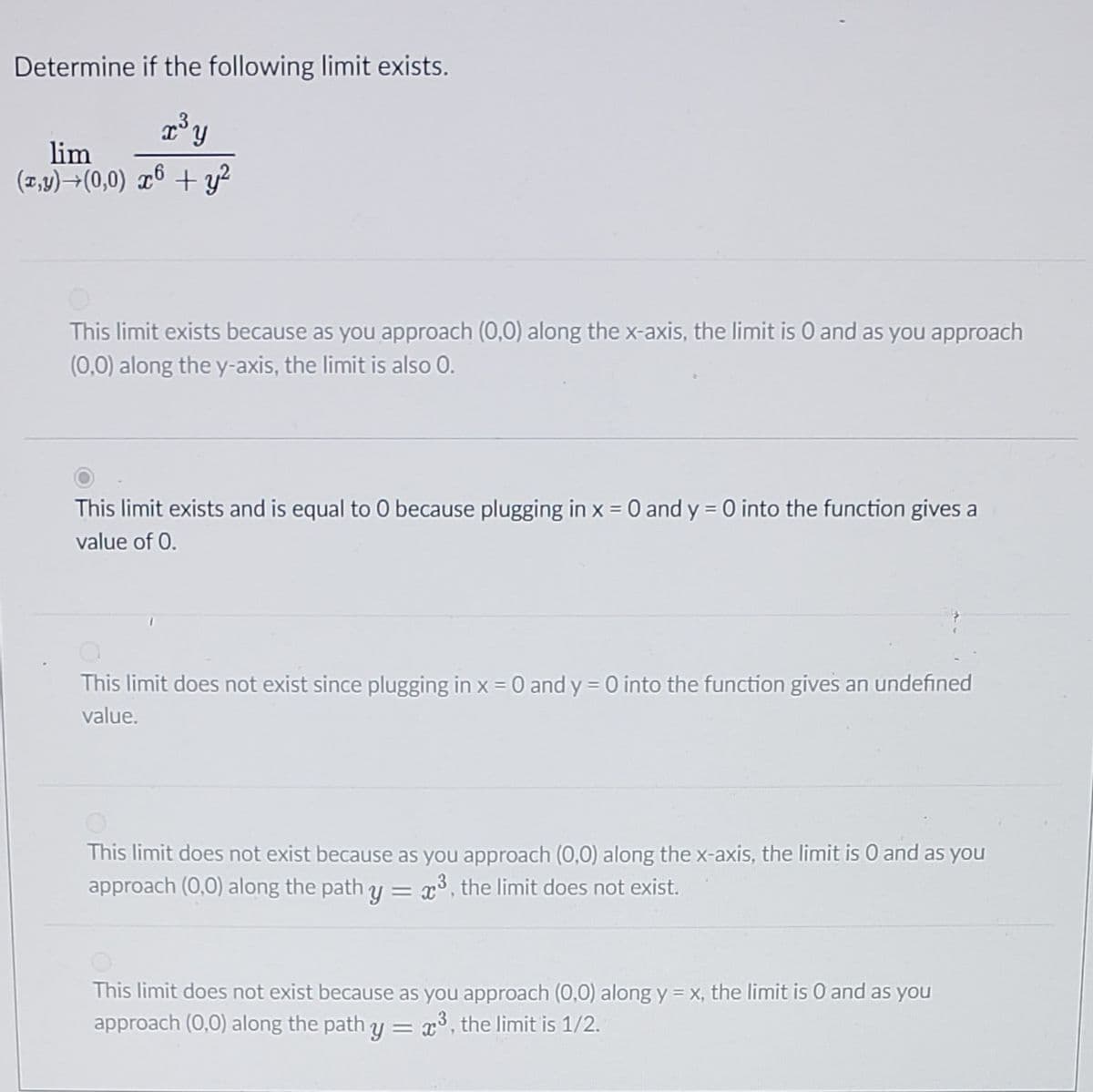Determine if the following limit exists. lim (1,v)→(0,0) x6 + y? This limit exists because as you approach (0,0) along the x-axis, the limit is 0 and as you approach (0,0) along the y-axis, the limit is also 0. This limit exists and is equal to 0 because plugging in x = 0 and y = 0 into the function gives a value of 0. This limit does not exist since plugging in x = 0 and y = 0 into the function gives an undefined value. This limit does not exist because as you approach (0,0) along the x-axis, the limit is 0 and as you approach (0 0) along the nath 3 the limit dooc pot ovist
Determine if the following limit exists. lim (1,v)→(0,0) x6 + y? This limit exists because as you approach (0,0) along the x-axis, the limit is 0 and as you approach (0,0) along the y-axis, the limit is also 0. This limit exists and is equal to 0 because plugging in x = 0 and y = 0 into the function gives a value of 0. This limit does not exist since plugging in x = 0 and y = 0 into the function gives an undefined value. This limit does not exist because as you approach (0,0) along the x-axis, the limit is 0 and as you approach (0 0) along the nath 3 the limit dooc pot ovist
Calculus: Early Transcendentals
8th Edition
ISBN:9781285741550
Author:James Stewart
Publisher:James Stewart
Chapter1: Functions And Models
Section: Chapter Questions
Problem 1RCC: (a) What is a function? What are its domain and range? (b) What is the graph of a function? (c) How...
Related questions
Question

Transcribed Image Text:Determine if the following limit exists.
lim
(1,y)¬(0,0) x6 + y?
This limit exists because as you approach (0,0) along the x-axis, the limit is O and as you approach
(0,0) along the y-axis, the limit is also 0.
This limit exists and is equal to 0 because plugging in x = 0 and y = 0 into the function gives a
value of 0.
This limit does not exist since plugging in x = 0 and y = 0 into the function gives an undefined
value.
This limit does not exist because as you approach (0,0) along the x-axis, the limit is 0 and as you
approach (0,0) along the path y = x3, the limit does not exist.
This limit does not exist because as you approach (0,0) along y = x, the limit is 0 and as you
approach (0,0) along the path y = x³, the limit is 1/2.
%3D
Expert Solution
This question has been solved!
Explore an expertly crafted, step-by-step solution for a thorough understanding of key concepts.
This is a popular solution!
Trending now
This is a popular solution!
Step by step
Solved in 2 steps with 2 images

Knowledge Booster
Learn more about
Need a deep-dive on the concept behind this application? Look no further. Learn more about this topic, calculus and related others by exploring similar questions and additional content below.Recommended textbooks for you

Calculus: Early Transcendentals
Calculus
ISBN:
9781285741550
Author:
James Stewart
Publisher:
Cengage Learning

Thomas' Calculus (14th Edition)
Calculus
ISBN:
9780134438986
Author:
Joel R. Hass, Christopher E. Heil, Maurice D. Weir
Publisher:
PEARSON

Calculus: Early Transcendentals (3rd Edition)
Calculus
ISBN:
9780134763644
Author:
William L. Briggs, Lyle Cochran, Bernard Gillett, Eric Schulz
Publisher:
PEARSON

Calculus: Early Transcendentals
Calculus
ISBN:
9781285741550
Author:
James Stewart
Publisher:
Cengage Learning

Thomas' Calculus (14th Edition)
Calculus
ISBN:
9780134438986
Author:
Joel R. Hass, Christopher E. Heil, Maurice D. Weir
Publisher:
PEARSON

Calculus: Early Transcendentals (3rd Edition)
Calculus
ISBN:
9780134763644
Author:
William L. Briggs, Lyle Cochran, Bernard Gillett, Eric Schulz
Publisher:
PEARSON

Calculus: Early Transcendentals
Calculus
ISBN:
9781319050740
Author:
Jon Rogawski, Colin Adams, Robert Franzosa
Publisher:
W. H. Freeman


Calculus: Early Transcendental Functions
Calculus
ISBN:
9781337552516
Author:
Ron Larson, Bruce H. Edwards
Publisher:
Cengage Learning